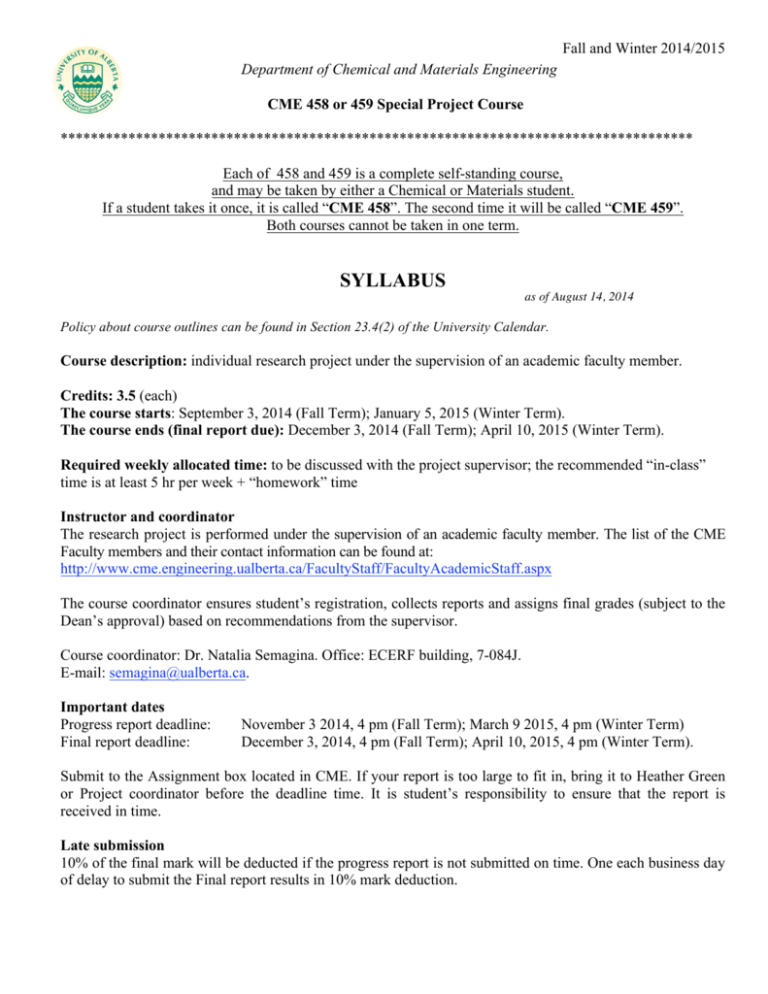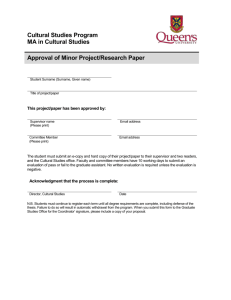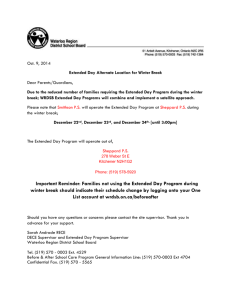syllabus - Department of Chemical & Materials Engineering
advertisement

Fall and Winter 2014/2015 Department of Chemical and Materials Engineering CME 458 or 459 Special Project Course ** ************************************************************************************ Each of 458 and 459 is a complete self-standing course, and may be taken by either a Chemical or Materials student. If a student takes it once, it is called “CME 458”. The second time it will be called “CME 459”. Both courses cannot be taken in one term. SYLLABUS as of August 14, 2014 Policy about course outlines can be found in Section 23.4(2) of the University Calendar. Course description: individual research project under the supervision of an academic faculty member. Credits: 3.5 (each) The course starts: September 3, 2014 (Fall Term); January 5, 2015 (Winter Term). The course ends (final report due): December 3, 2014 (Fall Term); April 10, 2015 (Winter Term). Required weekly allocated time: to be discussed with the project supervisor; the recommended “in-class” time is at least 5 hr per week + “homework” time Instructor and coordinator The research project is performed under the supervision of an academic faculty member. The list of the CME Faculty members and their contact information can be found at: http://www.cme.engineering.ualberta.ca/FacultyStaff/FacultyAcademicStaff.aspx The course coordinator ensures student’s registration, collects reports and assigns final grades (subject to the Dean’s approval) based on recommendations from the supervisor. Course coordinator: Dr. Natalia Semagina. Office: ECERF building, 7-084J. E-mail: semagina@ualberta.ca. Important dates Progress report deadline: Final report deadline: November 3 2014, 4 pm (Fall Term); March 9 2015, 4 pm (Winter Term) December 3, 2014, 4 pm (Fall Term); April 10, 2015, 4 pm (Winter Term). Submit to the Assignment box located in CME. If your report is too large to fit in, bring it to Heather Green or Project coordinator before the deadline time. It is student’s responsibility to ensure that the report is received in time. Late submission 10% of the final mark will be deducted if the progress report is not submitted on time. One each business day of delay to submit the Final report results in 10% mark deduction. Fall and Winter 2014/2015 Note that the deadline extension is not possible, except for the reasons outlined at the University calendar (section 23.3 “Attendance”, such as incapacitating illness, severe domestic affliction, or religious convictions). Grading principles This is not a pass/fail course. The course coordinator will assign the final grade based on the supervisor’s recommendation and evaluation form, and will submit the grade to the Dean’s office for approval. 100% mark is based on the Final Report evaluation form to be completed by the project supervisor. The Final Report Evaluation raw score will be lowered by 10% for the failure to submit a progress report in time, and by 10% for each working day of delay of the Final report. For the percentage of the report evaluation, refer to the Evaluation form (appendix). A student passes the course with a score of 3 out of 5 or higher (after all applied deductions). A necessary condition to pass the course, along with the total score of 3, is that at least the “satisfactory” mark is assigned in both “Intellectual contribution to the project” and “Analytic content: quality of treatment”. How to register Note: a student cannot register on-line for this course, the registration must be done by Heather Green upon receiving the registration form as explained below. 1. The course is open only to Chemical or Materials students with a GPA of 3.0 or greater during the previous two academic terms. The prerequisite to CME 459 is CME 458. 2. Select a project from the Project List (Appendix), discuss it with a supervisor, complete the registration form (Appendix), obtain signatures from the Supervisor and Course coordinator (for CPC and Oilsands stream students only, the approval signature is also required from appropriate advisor). Return the signed completed form to Heather Green (ECERF, 7th floor, reception area) to complete your registration. 3. If a desired project is not included in the Project List, a student is encouraged to discuss such a project with the professor whom she/he considers best qualified as supervisor of the project. A brief written project description (title and one-page abstract) must be prepared and the project must be approved by the CME 458/459 coordinator (via e-mail). After that, the registration form should be signed and submitted as explained above. 4. A CME 458/459 project may not be combined with a Dean’s Research Award as the Award “can’t be concurrent with a project for which credit is received.” Requirements to the reports 1. The Progress Report should be 1-2 pages long, summarize the work done on the project and tasks still to be performed (“list” format is recommended). It is not graded per se, but the failure/delay of submitting it will result in 10% final mark deduction. Its purpose is to track student’s progress. 2. Final Report. There is no required page limit (unless indicated by the supervisor), please make sure that the content matches the evaluation criteria in the evaluation form (Appendix), unless a different report outline was approved by the supervisor and course coordinator. Typically, the report is about 20-30 pages (not including appendices with raw data, if any). For the CME 459 project, please keep in mind that this is a separate report, not cumulative with your previous CME 458 report. If any data from the CME 458 report is used, they should be properly cited and distinguished from the current work. Fall and Winter 2014/2015 All reports will be handed in to the course coordinator, Heather Green, or submitted to the Assignment box before the deadline time. The course coordinator will distribute the reports to the appropriate supervisor(s). The late submission will be penalized as discussed above. Academic integrity The University of Alberta is committed to the highest standards of academic integrity and honesty. Students are expected to be familiar with these standards regarding academic honesty and to uphold the policies of the University in this respect. Students are particularly urged to familiarize themselves with the provisions of the Code of Student Behaviour (online at www.uofaweb.ualberta.ca/governance/studentappealsregulations.cfm) and avoid any behaviour which could potentially result in suspicions of cheating, plagiarism, misrepresentation of facts and/or participation in an offence. Academic dishonesty is a serious offence and can result in suspension or expulsion from the University. Audio/video recording Audio or video recording of lectures, labs, seminars or any other teaching environment by students is allowed only with the prior written consent of the instructor or as a part of an approved accommodation plan. Recorded material is to be used solely for personal study, and is not to be used or distributed for any other purpose without prior written consent from the instructor. Fall and Winter 2014/2015 CME 458/459 Special Projects in Materials Engineering DEPARTMENT OF CHEMICAL AND MATERIALS ENGINEERING PROJECT SELECTION (REGISTRATION FORM) Indicate which course you will be registering for: CME458 _______ CME 459 ________ Term in which the project is to be completed (circle): Fall Term (Sept-Dec) Winter Term (Jan-April) Spr/Sum Term (May-Aug) Name of Student: ___________________________________ ID No. ________________ No. of Project in Listing: _______ Title of Project: __________________________________________________________________ Supervisor(s): ___________________________________________________________________ (Please print) Signature of Supervisor(s): ________________________________________________________ Signature of Course Coordinator: __________________________________________________ Dr. Natalia Semagina If your Project is not listed, please provide a short written description of the project to the Course Coordinator. __________________________________________________________________________ ** For CPC and Oilsands stream students only, approval is required from appropriate advisor. Please indicate program: Chemical CPC ________ Chemical Oilsands _________ Name: __________________________ Signature: _______________________________ (Please print) (Advisor) Fall and Winter 2014/2015 CME 458/459 Special Projects DEPARTMENT OF CHEMICAL AND MATERIALS ENGINEERING Final Report Evaluation Form Project: CME 45___ Term:____________ Student: ______________________________ID: _______________ Supervisor(s) (Print name): __________________________________________________ Co-supervisors: if the work was equally shared, each of you may provide your own evaluation and the coordinator will use the average value. Alternatively, upon agreement, you may submit one Evaluation Form signed by both of you. The Course includes an Engineering design component, which is defined by CEAB as “an ability to design solutions for complex, open‐ended engineering problems and to design systems, components or processes that meet specified needs with appropriate attention to health and safety risks, applicable standards, and economic, environmental, cultural and societal considerations. Engineering design integrates mathematics, natural sciences, engineering sciences, and complementary studies in order to develop elements, systems, and processes to meet specific needs. It is a creative, iterative, and open‐ended process, subject to constraints which may be governed by standards or legislation to varying degrees depending upon the discipline. These constraints may also relate to economic, health, safety, environmental, societal or other interdisciplinary factors”. Evaluation criteria: A student passes the course with a score of 3 out of 5 or higher (after all applied deductions); the final grade will be assigned by the course coordinator. A necessary condition to pass the course, along with the total score of 3, is that at least the “satisfactory” mark is assigned in both “Intellectual contribution to the project” and “Analytic content: quality of treatment”. The Final Report Evaluation raw score will be lowered by 10% for the failure to submit a progress report in time, and by 10% for each working day of delay of the Final report. The course coordinator will assign the final mark and submit it to the Dean’s office for approval. Other comments (if any): The supervisor may suggest a grade. If more than one student is supervised, please indicate the approximate ranking, which the course coordinator will take into consideration Signature(s) of the supervisor(s), date ______________________________________________________________ Fall and Winter 2014/2015 ****************** To be completed by the Course Coordinator ***************** Raw score based on the above evaluation:_______________ At least a “satisfactory” mark is assigned in both “Intellectual contribution to the project” and “Analytic content: quality of treatment” Final report handed in in time, with delay _____ days (penalty 10% of the report mark per one working day of delay) Progress report handed in in time, not handed in (penalty 10%) Final mark:___________________ Course coordinator:__________________________________________ Name, signature, date Fall and Winter 2014/2015 CME 458-459 PROJECT LIST 2013-2014 If a desired project is not included in the Project List, a student is encouraged to discuss such a project with the professor whom she/he considers best qualified as supervisor of the project. A brief written project description (title and one-page abstract) must be prepared, and the project must be approved by the CME 458/459 coordinator. ************************************************************************** Project 1: Oxidation of asphaltenes Supervisor: A. de Klerk Type of Project: Experimental Number of Students: 1 Most of the challenges in bitumen upgrading are related to its composition and lack of fluidity. Bitumen is not only heavy, but it also contains a significant fraction of asphaltenes, i.e. they represent more than 10 wt% of the total bitumen. Asphaltenes are a solubility class. They contain the heaviest and most polar compounds in crude oil; even more, asphaltenes are the main cause of catalyst deactivation and coke formation. Therefore, they are considered the least favorable fraction for upgrading. Efficient conversion of asphaltenes to liquids is one of the key challenges faced by industry. Although asphaltenes are considered a low value solid, they have the potential to be converted to higher value liquid products. Industrially there are pathways for doing so, but the liquid yield is limited and the processes require severe conditions. It is desirable to find different conversion chemistries. Oxidation of asphaltenes has been proposed as an alternative. There are few patents in the literature that claim how asphaltenes can be upgraded through oxidation. Moreover, production of different useful liquid products, e.g. drying oils, varnishes, refinery feedstocks, has been reported. The aim of this project is to review and repeat some of the examples presented in patents related to oxidation of asphaltenes. Real industrial asphaltenes will be used to perform the experiments. Basic characterization of this material will be done. Also, the oxidation products will be analyzed with instrumental techniques suitable for dealing with heavy and complex mixtures. Project 2: Silk - a reinvented functional material from biological source Supervisor: Hyun-Joong Chung Type of Project: Experimental Silk - an 'old' fabric material that can be obtained from biological source - is recently reinvented to various functional materials, where the application ranges from wound dressing, controlled drug delivery, and biosensors. The scope of the special research project will span various stages of research activity, including literature survey, decision making, experimental design, and actual material synthesis and characterization. The recipient will have unique opportunity to build up a research project on his own with close direct advising from a faculty advisor. Fall and Winter 2014/2015 Project 3: Blood glucose sensor Supervisor: Stevan Dubljevic Type of Project: Computational The fast and reliable glucose sensor needs to be realized as simple input-output relationship between the changes in the blood glucose concentration and sensing device, see Fig.1. In particular, we are looking in the representation in the following form: The important aspect of the model is that sensor data are discrete functions in time, that is a measurement of the glucose that is registered at sensing cite, which is taken in some time intervals. In other words, the output of the model is discrete function of time y(t) y(k) where k -represents time instance. Having the spatially distributed nature of the system on one side, the discrete measurements of glucose taken at the time sample instances which are specified by the sensor features on the other, one needs to incorporate all these aspects in robust, cheap, and reliable sensing mechanism to address accurate enough on-line real measurement of glucose in blood. Project 4: Solidification of an aluminum bulk metallic glass Supervisor: H. Henein Type of Project: Experimental Bulk metallic glasses are a new class of materials characterized by their amorphous structure under low cooling rates of solidification. The resultant alloy has high hardness and low ductility. Some of these new classes of alloys are incorporated into new designs of golf clubs. A new Al based bulk amorphous alloy will be atomized and the structure characterized using x-ray, and microscopy techniques. The hardness of the alloy will also be measured. A model of droplet cooling will be used to estimate the droplet cooling rate prior to solidification. The resultant structure and properties will be related to the droplet cooling rate. Engineering objectives: •Develop experimental testing strategy. •Carry out atomization experiments. •Use of various microscopy techniques to characterize the solidified microstructure. •Carry out x-ray diffraction analysis of powders. •Use hardness measurements to estimate the mechanical properties. •Relate mechanical properties to the evolution of microstructure. Fall and Winter 2014/2015 Project 5: The Effect of Warm Rolling on the Morphology of Cementite in Low alloy Steels Supervisor: H. Henein Type of Project: Experimental Number of Students: 2 Low alloy steels are used for down hole applications in the oil and gas sector. As down hole conditions of oil and natural gas extraction are worsening, producers encounter the presence of hydrogen sulfide with consequences such as sulfide stress cracking (SSC) instigated by hydrogen. There is increasing evidence that the morphology of cementite in these quench and tempered steels plays a role in the SSC behaviour. The objective of this project is to explore the use of warm rolling as a processing strategy to modify the morphology of cementite. The project will involve carrying out a literature review on the subject, plan and execute an experimental warm rolling test matrix, followed by the quantitative characterization of the microstructure using Optical and SEM microscopy, X-ray diffraction. In addition, other characterization techniques such as hardness measurements may be used as needed. An analysis of the experimental and characterization results will be carried out. Project 6: Development of Novel Bifunctional Catalysts for Rechargeable Zn-air Batteries Supervisor: D.G. Ivey (780-492-2957 and doug.ivey@ualberta.ca) Type of Project: Experimental Number of Students: 1 per project Peak oil and the effects of global warming have encouraged the development of new alternative energy storage devices such as supercapacitors, fuel cells and batteries. Zinc-air batteries are a promising candidate because of their high energy density, cost-effectiveness and environmentally-friendly nature. Rechargeable Zn-air batteries have potential applications in various areas such as portable electronic devices and electric vehicles. In a Zn-air battery, the oxygen evolution reaction (OER) and oxygen reduction reaction (ORR) occur at the air electrode (cathode) during charge and discharge, respectively. Currently, the overall performance and lifetime of zinc-air batteries is limited by the lack of effective bifunctional electrocatalysts for ORR and OER at relatively low overpotential. Although Pt and Ir based catalysts exhibit the best overall bifunctional activity, their high cost and limited availability necessitate the fabrication of new non-precious metal catalysts. Several potential catalysts materials are been investigated, including transition metal oxides and intermetallics. The work will involve fabricating, characterizing and testing candidate materials using methods such as electrodeposition, x-ray diffraction, electron microscopy, cyclic voltammetry and rotating disk electrode analysis. Project 7: Corrosion Resistance of Alloy 690 Supervisors: J. L. Luo Type of Project: Experimental Number of Students: 1 Alloy 690 is the key material of steam generator tubing in CANdu power plant reactors. The corrosion degradation is one of the issues that threaten the safety operation of power plant. Some impurities in the secondary side may cause corrosion degradation of this alloy. The corrosion resistance at room temperature for alloy 690 has not been investigated previously. Therefore, the research objective of this paper is to investigate the corrosion resistance of Alloy 690 in simulated crevice chemistries at room temperature and various pH (neutral, acidic, basic). Fall and Winter 2014/2015 Project 8: Computational modeling of mono and poly-disperse spherical particles packed in enclosures with different geometries Supervisor: P. Nikrityuk Type of Project: Computational Number of Students: 1 or 2 The thermal-fluid characteristics of devices consisting of a packed bed of discrete particles, e.g. heatexchange-regenerators or fixed bed catalytic reactors, depend on an effective porosity distribution within the 'matrix' (fixed bed). For example the matrix packing used in many regenerators is represented by randomly packed spheres. A critical issue in prediction of fixed-bed-device characteristics, e. g. heat transfer rates, is near wall regions where the void fraction (volume fraction of gas phase) is not homogeneous. Using direct modeling of the void fraction distribution in packed beds can help to optimize their thermal-fluid characteristics. In this view, the main subject of this special project is to model packing of mono/polydisperse spherical particles in different enclosures using discrete element model (DEM). Open-source non-commercial DEM software is going to be used. Different enclosure shapes will be studied. Void fraction distribution will be calculated using MATLAB. Project 9: Video capture of liquid/liquid dispersion mechanisms in stirred tanks Supervisor: Suzanne M. Kresta (with Marcio Machado and Nitin Arora) Type of Project: Experimental Liquid/liquid dispersion in stirred tanks is important in a range of industrial applications such as: cosmetics, pharmaceutical and oil sands. The results for an oil-phase continuous system are different from the results for a water-phase continuous system, even in the same mixing equipment, due to the differences in surface charge. However there are no reported images and movies of this important difference which might help us to model and understand the phenomenon. Some work has been done in our research group in order to provide good quality images and movies showing the dispersion of one sparingly miscible fluid into another. Our next step is to look at differences between the two systems at the point of phase inversion. Two different stirred tank geometries and several impellers will be tested and the results will be used for validation of mathematical models and design of new experimental procedures. Project 10: Diffusion of gases in microporous solids Supervisor: Arvind Rajendran Type of Project: Experimental+computational Understanding the transport mechanism of gas molecules in zeolites is an important step for designing separation and catalytic processes. The necessary knowledge of mass transfer can be obtained by studying the diffusion of adsorbate (gas) molecules in the solid framework. Zero-length column (ZLC) technique has been widely used to measure intracrystalline diffusivity and mass transfer kinetics in porous materials by following the fast desorption curve of a pre-equilibrated sorbate. In this project, diffusion of gases in natural zeolites and reduced pore zeolite (RPZ) will be studied using ZLC technique. The effect of particle size on the diffusion rate in natural zeolites will be investigated to measure the properties of monolithic natural zeolites over a range of particle sizes made from dense geomorphic molecular sieve. The student involved in this project will receive training in advanced analytical tools, experimental design and on the measurement and modeling of gas diffusion.







